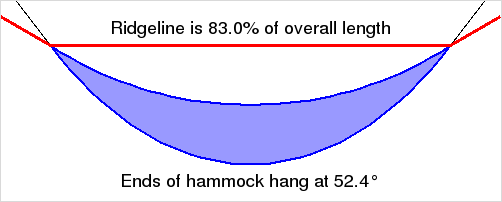How to stay dry with the right size tarp for hammocks
When readers choose to buy our independently choosen recommendations we recieve affiliate commissions to support our work. For more on this please see our Affiliate Disclaimer.
You gotta stay out of the rain right.
Or perhaps you just want to have a little more privacy.
Either way a tarp can do that for you.
So what size tarp is right for you?
The Answer: It depends
Now you remember back in this article about laying in a hammock properly how I mentioned the ridgeline distance.
Well if you don’t here’s a refresher.
Basically you want the distance from one end of your hammock to the other when it’s hanging to equal 83% of the overall length.
If you’ve tested it you can start with a different ridgeline length, this is just a good starting point.

Image courtesy of Kenny on Flickr
So if you’re using the Kammok Roo your overall length is 10 feet which is 120 inches. So let’s run that through our fancy calculator to get our answer.
120 * .83 = 99.6
So in this situation you would have a ridgeline of about 8 feet and 3.5 inches (or 99.5 inches).
Now that we have our optimal ridgeline length how’s that transfer to tarp size?
Easy, you want a tarp that has a 1 to 2 foot longer ridgeline than your hammock.
Most hammock tarp manufacturers list the ridgeline length for their tarps. If you can’t find it just contact their support and they’ll help you out.
Why is it Important to have a properly sized tarp
Well let me paint you a picture.
You’re laying in your hammock after spending the evening out by the campfire with your buddy.
A couple beers down and it’s time to go to sleep.
You hop in your hammock. Close off the bug net. And start to doze off.
A few hours later there’s a trickle of rain.
Not a lot.
But just enough to get you wet.

And instead of staying asleep with the calming pitter patter of the rain drops hitting your tarp, you wake up in a puddle.
In a panic you’re not sure what’s going on.
Jump out of your hammock.
Stumble around looking at the puddle in your hammock and at your tarp wondering if there’s a hole in it.
Instead you come to find out that your tarp is 6 inches too short.
So in other words the rain has a direct line into your hammock.
This folks is why having the right size tarp is extremely important for hammock camping.
And that’s not the only step to staying dry in your hammock. There’s also drip lines.
If you don’t use a drip line your suspension is basically and invitation for water to flow directly in to your hammock.
So don’t forget these either like I did on one of my hikes (which was a recipe for a terrible nights sleep).
BONUS: Download The FREE 5 Step Checklist I Use to Guarantee Myself a Good Nights Sleep in a Hammock